|
R e d A r r o w and H i g h S p e e d
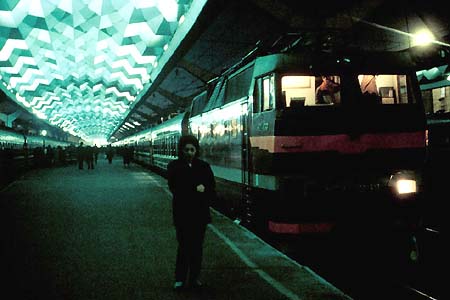 Express 1 Krasnaya Strela (Red Arrow) with ChS2T from Czech production and express 3 Leningrad - Moscow, at Leningrad 1986 (WS)
Express 1 Krasnaya Strela (Red Arrow) with ChS2T from Czech production and express 3 Leningrad - Moscow, at Leningrad 1986 (WS)
Slaves had built the Nikolai railway from St. Petersburg to Moscow, completed in 1851. Until 1911 the Kurier 1 had exclusively 1st class - hauled by the N series
2-6-0s.
After the revolution the "October" railway Moscow - Leningrad once again became the line of prestige. In 1920 a battery-driven test railcar-set was tried there. The Tudor batteries were from a submarine. Lenin financed in 1924 also the construction of the first diesel-electric locomotive, the Shch EL1, designed by Professor Gakkel, equipped with Vickers engines from a submarine. "Electric energy plus communism means future", that slogan has been ascribed to Lenin.
On June 10, 1931 started Krasnaya Strela, the Red Arrow, hauled possibly by series L Pacifics and temporarily by the "Josef Stalin" IS (2-8-4), one of them streamlined. From 1934 a fast 4-8-4 was planned, but then appeared the streamlined "2-3-2" (4-6-4) prototypes no.1 and 2 on the October railway and later also the different no. 3 or 6998. After WWII, nos. 1 and 2 lost their casing, but the blue 6998 on trials attained 175 km/h. Traction generally was by a blue Su (2-6-2) and then by the new P36 (4-8-4), including the P36-0001 prototype. The heavier 4-6-4 and 4-8-4 with 22.5 tons axle load were not built. In the '50s also a 6-sleeping-car diesel unit DP-0 from Mavag did run on the October railway.
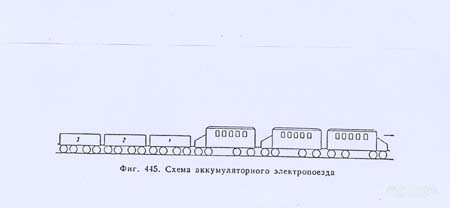
The battery-driven test railcar of 1920 (Rakov, coll. J.B. Kronawitter)
|
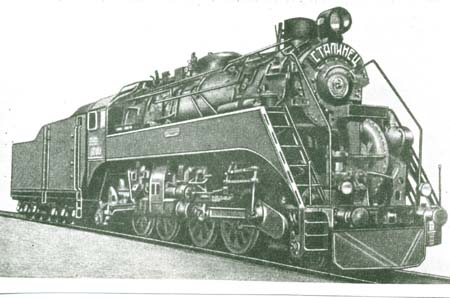
Steam- and diesel-powered 'Stalinets' 8000, tested also on the October railway with passenger and freight trains (Rakov, coll. J.B. Kronawitter)
|
|
Test engine 2-3-2 'XX October', Kolomna 1937/38 (Rakov, coll. J.B. Kronawitter)
|
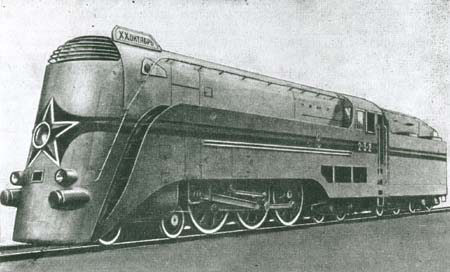
|
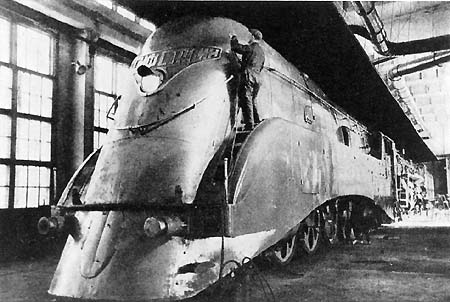
The only streamlined IS20-16 "Josef Stalin", a very rare picture (coll. J.B. Kronawitter)
|
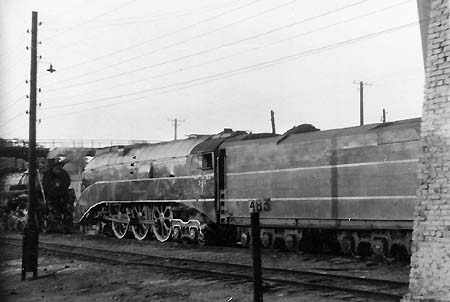
The record-breaking 2-3-2 no.3, the only known photograph in service, secretly taken at Kalinin, July 1957 (J.H. Price)
|
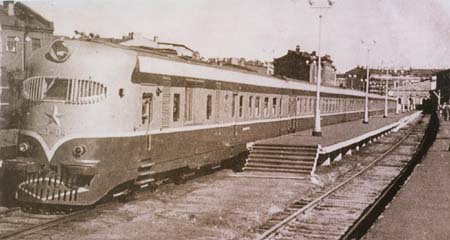
Sleeper-railcar series DP, built in Hungary 1946, employed Moscow - Leningrad, 1959 (Josef-Otto Slezak)
|
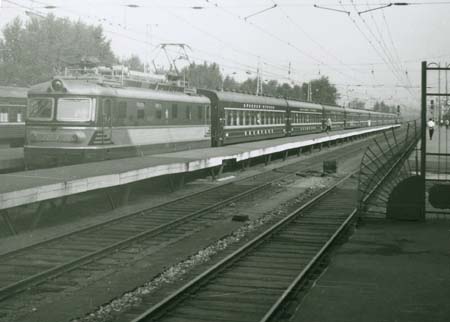
Krasmaya Strela with ChS2-611 and dark-red sleeping-cars, arriving at Moscow 1966 (Dr. Fritz Stoeckl)
|
Half a dozen night trains continued running between Moscow and St. Petersburg. The Red Arrow did get a competitor, the blue Nikolayevski Express and in 2005 a new luxurious Express, appreciated by businessmen avoiding the dangers of Russian air travel.
Krasnaya Strela Express
Moscow Okt. - Leningrad Okt., 1954:
Su (2-6-2)
8 Myagki (soft sleepers, mostly 2-berth, also 4-berth compartments),
1 Restoran
1 Pochtovyi
Colors: dark-blue
Krasnaya Strela Express
Leningrad - Moscow, May 5, 1986:
| ChS2T (CoCo d.c. 3kV) |
| Nos. 1-4 | Mest 36 | (sleeper, 4-berth) |
| No. 5 | Mest 16 | (sleeper, 2-berth) |
| Nos. 6-11 | Mest 18 | (sleeper, 2-berth) |
| Nos. 12-15 | Mest 36 | (sleeper, 4-berth) |
Mest 16 2-berth (en suite lavatories), Mest 18 2-berth (only lower berths).
Colors: Locomotive and cars dark-red.
High-speed
Among the 3kV dc electric locomotives the Czech ChS200 (2xBoBo) for 200 km/h, hauling the faster day train Aurora, and the similar ChS6 became predecessors of high-speeds services. In 1974 appeared the ER200 high-speed electric unit, but it remained a prototype. Also the development of the dual-system railcar "Sokol" VSM250 for a 250 km/h high-speed line was hampered. A high-speed track to the Black Sea, decided in 1988, of course was not built.
In 2004, when Russian president Putin together with German chancellor Schroeder had an ICE trip through Northern Germany, a contract for a Russian high-speed train production based on the German ICE3 was signed. First services Moscow - St. Petersburg with a top speed of 250 km/h were intended for the end of the year 2007 and also services St. Petersburg - Helsinki and Omsk - Novosibirsk were planned. The project was delayed, but finally in 2008 Siemens presented its Velaro type high-speed train at St. Petersburg. The ICE3 variant “Sapsan” for 3kV DC was to take up St. Petersburg – Moscow services in late 2009, followed in 2010 by a 25kV50Hz variant running Moscow – Nizhni Novgorod. Extension of the network is expected.
Not for true high-speed, but for a speed of 160km/h, a deal for the Desiro RUS was signed with Siemens in 2011. For international traffic from Moscow to Berlin and Prague, Talgo train sets with automatic gauge-changing were evaluated already around 2010. Among electric locomotives, the Czech-built of the 70s and other ones were replaced by new Russian types, twin and single, a.c., d.c. and dual-voltage, also in collaboration with foreign producers. In 2010 the Federal Passenger Company (FPC) was formed, described as a 100% subsidiary of RZhD.
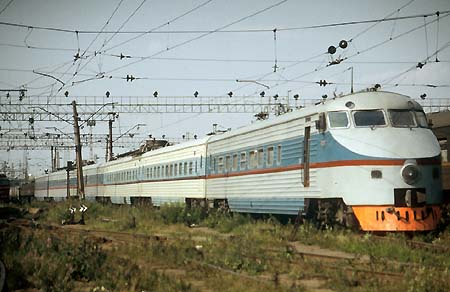 High-speed prototype ER200 for St. Petersburg - Moscow, St. Petersburg 1992 (Hans-Herbert Frohn)
High-speed prototype ER200 for St. Petersburg - Moscow, St. Petersburg 1992 (Hans-Herbert Frohn)
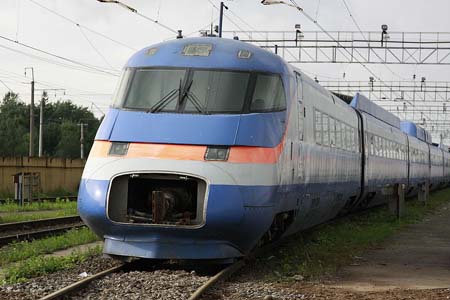
Sokol in depot (Moroslov L.N., via Wikimedia)
|
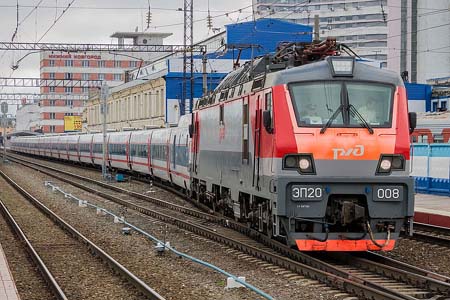
Talgo Nizhni Novgorod – Moscow, engine EP20 (Neu-Zwei, via Wikimedia)
|
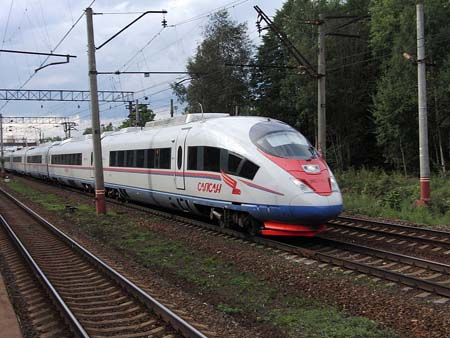
Sapsan St. Petersburg - Moscow, passing Zelinograd, 2010 (Mikhail Shckerbakov, via Wikimedia)
|
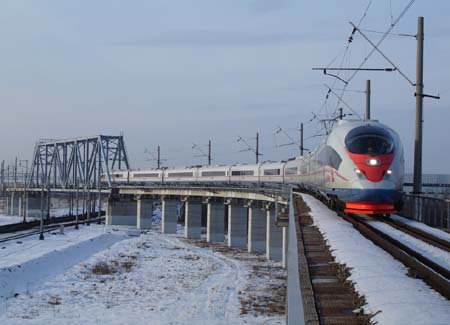
Sapsan high-speed train in Russia, 2009 (Siemens)
|
|
















